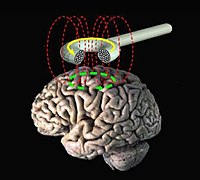
Photo from wikipedia
Deep brain stimulation of the anterior nucleus of the thalamus (ANT-DBS) has been shown to be effective and safe in the long-term treatment of refractory epilepsy. However, the mechanisms by… Click to show full abstract
Deep brain stimulation of the anterior nucleus of the thalamus (ANT-DBS) has been shown to be effective and safe in the long-term treatment of refractory epilepsy. However, the mechanisms by which ANT-DBS controls epilepsy at the gene expression level (e.g., which regulatory mechanisms are altered) is not well understood. Nine rats were randomly assigned to the control group, the kainic acid (KA) group, and the DBS group. Temporal lobe epilepsy in rats was induced by a stereotaxic KA injection (KA group). The DBS group received the KA injection followed by treatment with ANT-DBS. Video-electroencephalogram (EEG) was used to monitor seizures. Total RNA samples were isolated from the hippocampus of three groups. Microarray was used to detect differentially regulated mRNAs. GO and pathway analysis were performed to analyze the functional categories and affected pathways. qPCR was used to prove the reliability of the microarray results. The differentially expressed genes the KA group and the DBS group, relative to the control group, were screened and a total of 2910 genes were identified. These genes were involved in functional categories such as ion channel activity (P = 5.01 × 10−8), gated channel activity (P = 1.42 × 10−7), lipid binding (P = 4.97 × 10−5), and hydrolase activity (P = 5.02 × 10−5) and pathways such as calcium signaling pathway (P = 2.09 × 10−8), glutamatergic synapse (P = 4.09 × 10−8) and NOD-like receptor signaling pathway (P = 2.70 × 10−6). Differentially expressed mRNAs might play a role in the pathogenesis of temporal lobe epilepsy. Calcium signaling pathways, synaptic glutamate, and NOD-like receptor signaling pathway play a central role in normal-epilepsy-ANT-DBS treatment series. ANT-DBS achieves its antiepileptic effects by modulating target genes involved in a variety of functions and pathways.
Journal Title: Acta Neurologica Belgica
Year Published: 2019
Link to full text (if available)
Share on Social Media: Sign Up to like & get
recommendations!